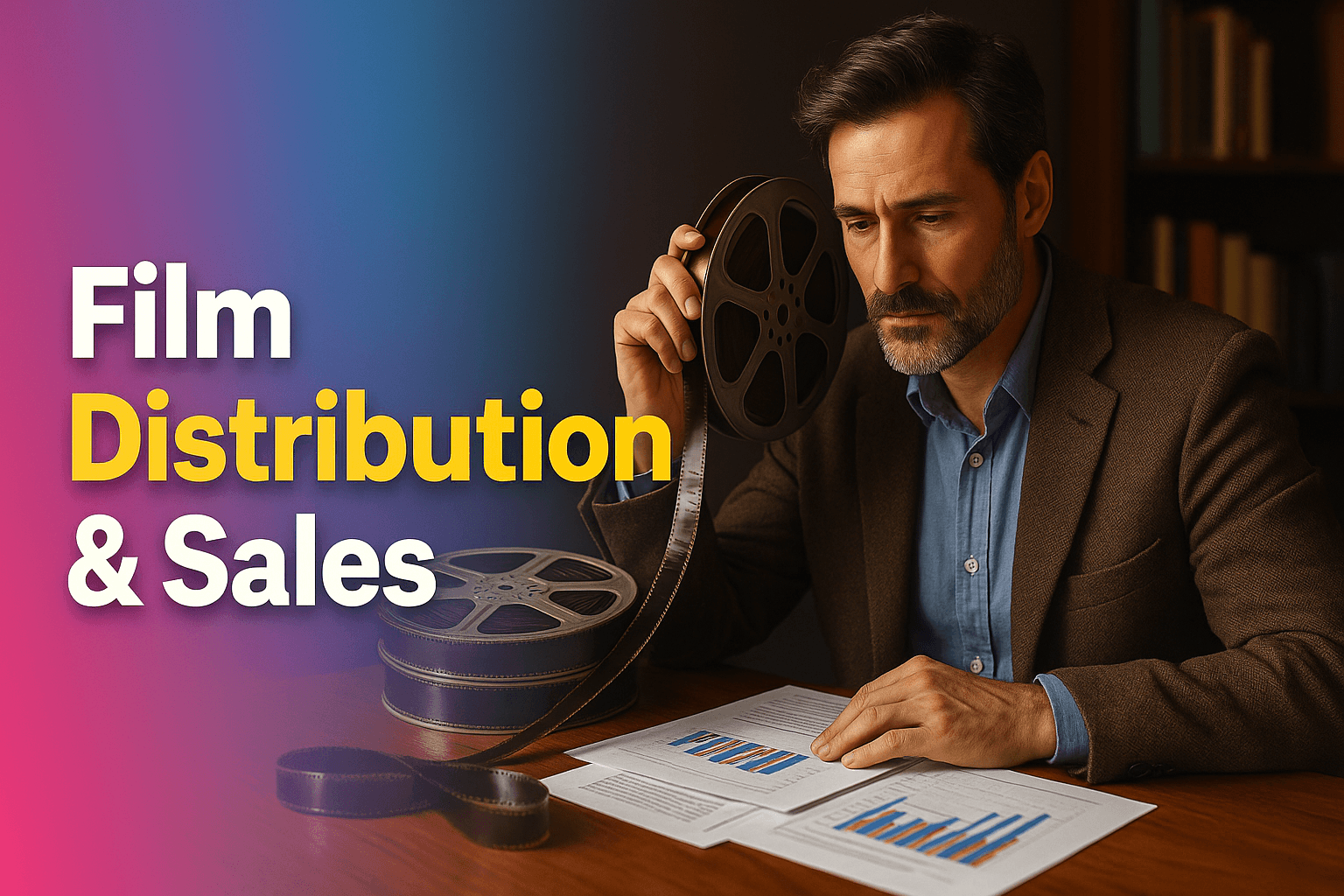The Strategic Blueprint for Film Distribution & Sales

Introduction
In my analysis, a film is only a product in its conceptual form. Its true value is realized through a meticulously planned and executed sales strategy for film distribution. Today, it is a complex, multi-tiered process governed by data, global market trends, and a nuanced understanding of a fragmented landscape.
This guide provides a strategic blueprint, deconstructing the ecosystem, identifying critical milestones, and demonstrating how a data-driven approach is no longer a luxury—it is the foundation for profitability.
Key Takeaways
| Core Challenge | The film distribution landscape is increasingly fragmented, with traditional theatrical models competing against a global network of digital platforms, making a cohesive sales strategy difficult to execute. |
| Strategic Solution | Leverage a data-driven approach to identify the most commercially viable distribution windows, understand audience trends, and target the right sales agents and distributors for your project. |
| Vitrina’s Role | Vitrina provides the verified intelligence needed to map the global industry, allowing you to discover sales agents, connect with acquisition executives, and track your competitors’ market strategies. |
Deconstructing the Film Sales Ecosystem: Sales Agent vs. Distributor
The first step in building a robust sales strategy for film distribution is to understand the two primary players in the ecosystem: the sales agent and the distributor. While often confused, their roles are distinct and interconnected.
The Sales Agent: A sales agent acts as the producer’s representative. Their core function is to sell the rights of a film to distributors across different territories and platforms (e.g., theatrical, home video, TV, VOD). They are the dealmakers who attend film markets (like Cannes, AFM, or the EFM) and festivals, pitching the film to a global network of buyers. They do not typically market the film directly to the public; their focus is on business-to-business (B2B) transactions.
The sales agent will take a commission on the sales they secure, often ranging from 10% to 30%, and may also recoup marketing and travel expenses from the film’s revenue. They are the crucial bridge between a finished film and its potential for a global audience.
The Distributor: A distributor acquires the rights to a film for a specific territory or set of territories. Their role is to market and release the film to the public. They handle everything from securing a theatrical release to marketing on digital platforms, managing the supply chain for physical media, and promoting the film to its target audience.
The distributor often pays an advance to the sales agent or producer for the rights, and may share in the profits from the film’s performance after recouping their marketing and distribution expenses. In the modern era, distributors range from traditional theatrical giants like Universal Pictures to digital-first companies and global streamers like Netflix and Amazon Prime Video.
The Core Components of a Modern Sales Strategy for Film Distribution
A successful sales strategy for film distribution begins long before the final cut. It is an integrated, end-to-end plan that evolves from a film’s inception to its global release. My analysis identifies these core components:
-
Audience & Market Research
The first and most critical step is to identify your film’s target audience. Who is this film for?
What are their viewing habits? What other films do they watch? This isn’t just about demographics; it’s about psychographics—understanding their interests, values, and media consumption. A comedy for the 18-24 demographic has a completely different sales strategy than a historical documentary targeting a 50+ audience. Identifying “comparables” (successful films in the same genre and budget range) is essential for proving market viability to sales agents and distributors.
This data-backed approach provides a foundation for every subsequent decision, from the choice of sales agent to the marketing materials.
-
The Sales & Marketing Plan
Once you understand your audience, you must create a compelling sales and marketing package. This goes beyond a film poster and a trailer. A robust sales package includes:
- A Trailer & Teaser: These are the single most important sales tools. A great trailer must sell the film’s concept, tone, and genre in under two minutes.
- Key Art & Press Kit: Professional key art and a comprehensive Electronic Press Kit (EPK) are non-negotiable. They must include high-resolution stills, cast and crew bios, a logline, and a synopsis.
- Festival & Market Strategy: A strategic approach to film festivals is vital. A premiere at a top-tier festival like Sundance or TIFF can generate buzz, critical acclaim, and bidding wars that can lead to lucrative distribution deals. Attending film markets like AFM or the EFM is where sales agents make their deals.
-
Navigating Distribution Windows
The traditional “waterfall” model of theatrical release followed by home video and television is now a relic of the past. Today’s strategy is a complex matrix of windows: theatrical, Transactional VOD (TVOD), Electronic Sell-Through (EST), Subscription VOD (SVOD), and Ad-Supported VOD (AVOD). A modern sales strategy for film distribution must consider a hybrid approach. For example, a limited theatrical run can generate publicity and critical reviews to boost a subsequent SVOD release on a global streamer, which, in turn, can unlock new revenue streams from ancillary rights.
The rise of digital platforms has given producers more control and a direct line to audiences. Platforms like Vimeo on Demand and YouTube Rentals allow for self-distribution, giving a direct path to the consumer and bypassing traditional sales agents and distributors for certain projects. However, this also shifts the marketing and promotion burden entirely onto the producer.
The Role of Data & AI in a Modern Film Sales Strategy
In the past, film sales were largely based on instinct, relationships, and “gut feelings.” Today, data analytics and AI are transforming the process into a precise, quantifiable science. This is where the competitive advantage is won or lost. My research reveals three key applications:
- Predictive Analytics: Big data can be used to forecast a film’s potential box office performance and audience engagement. By analyzing social media buzz, trailer views, and search trends, an algorithm can provide a predictive score that helps sales agents and financiers make more informed decisions. This allows them to identify which projects are most likely to succeed in a crowded market.
- Targeted Distribution: Data helps identify which platforms are the best fit for a specific genre or audience. For example, a sales agent can use analytics to determine that a horror film would perform best on a niche horror SVOD service in a particular territory, rather than a broad-audience streamer. This precision minimizes risk and maximizes revenue potential.
- Competitive Intelligence: By analyzing the distribution history of comparable films, producers can identify which sales agents and distributors have a track record of success with similar content. This data allows you to create a targeted list of potential partners, dramatically increasing your chances of a successful deal. This is no longer about cold-calling; it’s about strategic, data-backed outreach.
Vitrina: Your Strategic Partner in Film Distribution
The challenges of a fragmented global market and the need for data-driven decisions are precisely what Vitrina was built to solve. Our platform provides the intelligence needed to execute an advanced sales strategy for film distribution by:
- Mapping the Global Landscape: Vitrina’s platform profiles over 300,000 production, finance, and distribution companies, providing you with a clear view of the global ecosystem. You can filter and search for sales agents and distributors by genre, track record, and region to find the perfect fit for your project.
- Accessing Verified Contacts: The platform profiles over 3 million executives and decision-makers, complete with their department and specialization. This enables you to bypass generic inquiries and connect directly with the specific acquisition executive responsible for buying your film’s genre. Learn how Vitrina transforms the entertainment supply chain.
- Gaining Competitive Intelligence: Our Projects Tracker provides real-time intelligence on thousands of films in development and production globally. This allows you to analyze what your competitors are working on, which sales agents they are partnering with, and how their projects are being positioned in the market. This level of insight is invaluable for sharpening your own strategy.
Conclusion: From Creative Vision to Commercial Success
A film’s journey from a creative vision to commercial success is a testament to both art and business. My analysis shows that a truly effective sales strategy for film distribution is no longer a last-minute addition but a central, integrated component of the entire production process.
The challenges of a crowded, data-rich market are real, but they are solvable with the right intelligence.
By understanding the roles of key players, building a comprehensive marketing plan, and leveraging data to make precise decisions, you can move your project from a concept to a global asset. In the end, a successful sales strategy is not about selling a film; it is about proving its commercial viability with a strategic, data-backed blueprint that leaves no room for guesswork.
Frequently Asked Questions
A sales agent acts on behalf of the producer to sell a film’s rights to distributors in different territories. A distributor then buys those rights for a specific territory and handles the film’s marketing and release to the public. In short, a sales agent sells to distributors, while a distributor sells to the audience.
A film aggregator is a company that acts as an intermediary between independent filmmakers and digital platforms like iTunes, Amazon Prime Video, and Google Play. They handle the technical aspects of delivering the film and negotiating a share of the revenue, providing a simplified path to digital distribution without a traditional distributor or sales agent.
There are four primary types of VOD, each representing a different business model: Transactional VOD (TVOD), where a viewer pays per-view to rent or buy a film; Electronic Sell-Through (EST), a sub-category of TVOD where the viewer purchases the film to own; Subscription VOD (SVOD), which is a library of content available for a monthly fee (e.g., Netflix); and Ad-Supported VOD (AVOD), where content is free to watch but includes advertisements (e.g., YouTube’s free content).
A film festival premiere can be a critical part of a film’s sales strategy. Premiering at a prestigious festival (like Cannes, Sundance, or TIFF) can generate significant buzz and critical acclaim, which can lead to multiple distributors bidding on the film’s rights. This competition can drive up the film’s value and lead to more lucrative deals. Festivals also provide a vital networking opportunity for producers, sales agents, and distributors to connect and make deals in person.

























